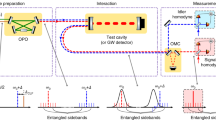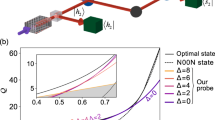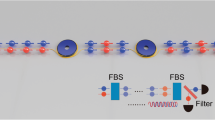Abstract
The recent series of gravitational-wave detections by the Advanced LIGO and Advanced Virgo observatories have launched the new field of gravitational-wave astronomy. As the sensitivity of gravitational-wave detectors is limited by the quantum noise of light, concepts from quantum metrology have been adapted to increase the observational range. Since 2010, squeezed light with reduced quantum noise has been used to achieve improved sensitivity at signal frequencies above 100 Hz. However, 100-m-long optical filter resonators would be required to also improve the sensitivity at lower frequencies, adding significant cost and complexity. Here, we report a proof-of-principle set-up of an alternative concept that achieves the broadband noise reduction by using Einstein–Podolsky–Rosen entangled states instead. We show that the desired sensitivity improvement can then be obtained with the signal recycling resonator that is already part of current observatories, providing a viable alternative to high-cost filter cavities.
This is a preview of subscription content, access via your institution
Access options
Access Nature and 54 other Nature Portfolio journals
Get Nature+, our best-value online-access subscription
$29.99 / 30 days
cancel any time
Subscribe to this journal
Receive 12 print issues and online access
$209.00 per year
only $17.42 per issue
Buy this article
- Purchase on Springer Link
- Instant access to full article PDF
Prices may be subject to local taxes which are calculated during checkout




Similar content being viewed by others
Data availability
The data that support the plots within this paper and other findings of this study are available from the corresponding author upon reasonable request.
References
Abernathy, M. et al. Einstein Gravitational Wave Telescope Conceptual Design Study Technical Report ET-0106C-10 (European Gravitational Observatory, 2011); https://tds.virgo-gw.eu/?call_file=ET-0106C-10.pdf
Lantz, B. et al. Instrument Science White Paper 2018 Technical Note LIGO-T1800133-v3 (LIGO Document Control Center, 2018); https://dcc.ligo.org/LIGO-T1800133/public
Abbott, B. P. et al. Exploring the sensitivity of next generation gravitational wave detectors. Classical Quantum Gravity 34, 044001 (2017).
Chan, M. L., Messenger, C., Heng, I. S. & Hendry, M. Binary neutron star mergers and third generation detectors: localization and early warning. Phys. Rev. D 97, 123014 (2018).
LIGO Scientific Collaboration and Virgo Collaboration. GW170817: observation of gravitational waves from a binary neutron star inspiral. Phys. Rev. Lett. 119, 161101 (2017).
Walls, D. F. Squeezed states of light. Nature 306, 141–146 (1983).
Breitenbach, G., Schiller, S. & Mlynek, J. Measurement of the quantum states of squeezed light. Nature 387, 471–475 (1997).
Schnabel, R. Squeezed states of light and their applications in laser interferometers. Phys. Rep. 684, 1–51 (2017).
Caves, C. M. Quantum-mechanical noise in an interferometer. Phys. Rev. D 23, 1693–1708 (1981).
Schnabel, R., Mavalvala, N., McClelland, D. E. & Lam, P. K. Quantum metrology for gravitational wave astronomy. Nat. Commun. 1, 121 (2010).
McClelland, D. E., Mavalvala, N., Chen, Y. & Schnabel, R. Advanced interferometry, quantum optics and optomechanics in gravitational wave detectors. Laser Photon. Rev. 5, 677–696 (2011).
The LIGO Scientific Collaboration. A gravitational wave observatory operating beyond the quantum shot-noise limit. Nat. Phys. 7, 962–965 (2011).
The LIGO Scientific Collaboration. Enhanced sensitivity of the LIGO gravitational wave detector by using squeezed states of light. Nat. Photon. 7, 613–619 (2013).
Grote, H. et al. First long-term application of squeezed states of light in a gravitational-wave observatory. Phys. Rev. Lett. 110, 181101 (2013).
Jaekel, M. T. & Reynaud, S. Quantum limits in interferometric measurements. Europhys. Lett. 13, 301 (1990).
Danilishin, S. L. & Khalili, F. Y. Quantum measurement theory in gravitational-wave detectors. Rev. Relat. 15, 5–147 (2012).
Kimble, H. J., Levin, Y., Matsko, A. B., Thorne, K. S. & Vyatchanin, S. P. Conversion of conventional gravitational-wave interferometers into quantum nondemolition interferometers by modifying their input and/or output optics. Phys. Rev. D 65, 022002 (2001).
Chelkowski, S. et al. Experimental characterization of frequency-dependent squeezed light. Phys. Rev. A 71, 013806 (2005).
Khalili, F. Y. Optimal configurations of filter cavity in future gravitational-wave detectors. Phys. Rev. D 81, 122002 (2010).
Barsotti, L., Harms, J. & Schnabel, R. Squeezed vacuum states of light for gravitational wave detectors. Rep. Prog. Phys. 82, 016905 (2018).
Ma, Y. et al. Proposal for gravitational-wave detection beyond the standard quantum limit through EPR entanglement. Nat. Phys. 13, 776–780 (2017).
Einstein, A., Podolsky, B. & Rosen, N. Can quantum-mechanical description of physical reality be considered complete? Phys. Rev. 47, 777–780 (1935).
Reid, M. D. Demonstration of the Einstein–Podolsky–Rosen paradox using nondegenerate parametric amplification. Phys. Rev. A 40, 913–923 (1989).
Bowen, W. P., Schnabel, R., Lam, P. K. & Ralph, T. C. Experimental characterization of continuous-variable entanglement. Phys. Rev. A 69, 012304 (2005).
Schori, C., Sørensen, J. L. & Polzik, E. S. Narrow-band frequency tunable light source of continuous quadrature entanglement. Phys. Rev. A 66, 033802 (2002).
Hage, B., Samblowski, A. & Schnabel, R. Towards Einstein–Podolsky–Rosen quantum channel multiplexing. Phys. Rev. A 81, 062301 (2010).
Brown, D. D. et al. Broadband sensitivity enhancement of detuned dual-recycled michelson interferometers with EPR entanglement. Phys. Rev. D 96, 062003 (2017).
Marino, A. M., Stroud, C. R. Jr, Bennink, R. S. & Boyd, R. W. Bichromatic local oscillator for detection of two-mode squeezed states of light. J. Opt. Soc. Am. 24, 335–339 (2007).
Li, W., Jin, Y., Yu, X. & Zhang, J. Enhanced detection of a low-frequency signal by using broad squeezed light and a bichromatic local oscillator. Phys. Rev. A 96, 023808 (2017).
Beckey, J. L., Ma, Y., Boyer, V. & Miao, H. Broadband quantum noise reduction in future long baseline gravitational-wave detectors via EPR entanglement. Phys. Rev. D 100, 083011 (2019).
Yap, M. J. et al. Generation and control of frequency-dependent squeezing via Einstein–Podolsky–Rosen entanglement. Nat. Photon. https://doi.org/10.1038/s41566-019-0582-4 (2020).
Acknowledgements
This work was funded by the Deutsche Forschungsgemeinschaft (DFG, German Research Foundation, SCHN 757/6-1), supported by the DFG under Germany’s Excellence Strategy EXC 2121 (‘Quantum Universe’, 390833306) and by the European Research Council (ERC) Project ‘MassQ’ (grant no. 339897).
Author information
Authors and Affiliations
Contributions
J.S., S.S. and R.S. planned the experiment. J.S. and S.S. built and performed the experiment. M.K. provided the theoretical analysis. All authors prepared the manuscript.
Corresponding author
Ethics declarations
Competing interests
The authors declare no competing interests.
Additional information
Publisher’s note Springer Nature remains neutral with regard to jurisdictional claims in published maps and institutional affiliations.
Rights and permissions
About this article
Cite this article
Südbeck, J., Steinlechner, S., Korobko, M. et al. Demonstration of interferometer enhancement through Einstein–Podolsky–Rosen entanglement. Nat. Photonics 14, 240–244 (2020). https://doi.org/10.1038/s41566-019-0583-3
Received:
Accepted:
Published:
Issue Date:
DOI: https://doi.org/10.1038/s41566-019-0583-3
This article is cited by
-
Entanglement-enhanced optomechanical sensor array with application to dark matter searches
Communications Physics (2023)
-
Full monitoring of ensemble trajectories with 10 dB-sub-Heisenberg imprecision
npj Quantum Information (2021)
-
Resource reduction for simultaneous generation of two types of continuous variable nonclassical states
Frontiers of Physics (2021)
-
Twin beam quantum-enhanced correlated interferometry for testing fundamental physics
Communications Physics (2020)
-
Generation and control of frequency-dependent squeezing via Einstein–Podolsky–Rosen entanglement
Nature Photonics (2020)



